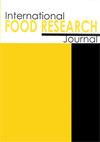Symbiosis of acetic acid bacteria and yeast isolated from black tea fungus mimicking the kombucha environment in bacterial cellulose synthesis
IF 1
4区 农林科学
Q4 FOOD SCIENCE & TECHNOLOGY
引用次数: 0
Abstract
The symbiotic effect of acetic acid bacteria and yeast on bacterial cellulose (BC) synthesis in kombucha was explored. Firstly, the optimal culture ratio of acetic acid bacteria and yeast was optimised through single factor and orthogonal test. The results showed that when Komagataeibacter intermedius:Brettanomyces bruxellensis:Zygosaccharomyces bisporus ratio was 1:10:10, and the inoculation amounts of K. intermedius, B. bruxellensis, and Z. bisporus were 104, 105, and 105 CFU/mL, respectively, the yield of BC was the highest, and the dry basis was 5.51 g/L. It was determined that the metabolites of B. bruxellensis and Z. bisporus could promote the synthesis of BC by K. intermedius. In addition, the composition of yeast filtrate was analysed by amino acid analyser, gas chromatography-mass spectrometry (GC-MS), and high performance liquid chromatograph (HPLC). Results showed that 16 amino acids were detected in yeast filtrate, and cysteine was only detected in yeast filtrate. The increase in isoleucine before and after fermentation was the highest, which was 11.64 times that of the control group. The increase in aspartic acid and glycine were second and third, accounting for 60.00 and 41.67%, respectively. The main volatile substances were alcohols, accounting for 84.89%, of which the relative content of ethanol was the highest at 77.35%. The relative contents of 3-methyl-1-butanol and phenylethanol were also high, accounting for 4.13 and 3.14%, respectively. Tartaric, citric, and succinic acids were detected in the yeast filtrate. The chemical species did not change before and after fermentation, but the content decreased. Vitamins B2 and B6 were detected in yeast filtrate, and the species and content did not change significantly before and after fermentation. A theoretical basis for kombucha fermentation and BC synthesis was provided.从模仿昆布茶环境的红茶真菌中分离出的醋酸菌和酵母菌在细菌纤维素合成中的共生关系
本研究探讨了醋酸菌和酵母菌对昆布茶中细菌纤维素(BC)合成的共生效应。首先,通过单因子和正交试验优化了醋酸菌和酵母菌的最佳培养比例。结果表明,当中间酵母菌(Komagataeibacter intermedius):布鲁氏酵母菌(Brettanomyces bruxellensis):双孢酵母菌(Zygosaccharomyces bisporus)的比例为 1:10:10,中间酵母菌(K. intermedius)、布鲁氏酵母菌(B. bruxellensis)和双孢酵母菌(Z. bisporus)的接种量分别为 104、105 和 105 CFU/mL 时,BC 的产量最高,干基为 5.51 g/L。结果表明,布鲁氏菌和双孢蘑菇的代谢产物可促进中间体合成 BC。此外,氨基酸分析仪、气相色谱-质谱联用仪(GC-MS)和高效液相色谱仪(HPLC)分析了酵母滤液的成分。结果表明,在酵母滤液中检测到 16 种氨基酸,仅在酵母滤液中检测到半胱氨酸。发酵前后异亮氨酸的增幅最大,是对照组的 11.64 倍。天门冬氨酸和甘氨酸的增幅位居第二和第三,分别占 60.00% 和 41.67%。主要挥发性物质是醇类,占 84.89%,其中乙醇的相对含量最高,为 77.35%。3 甲基-1-丁醇和苯乙醇的相对含量也很高,分别占 4.13% 和 3.14%。酵母滤液中检测到酒石酸、柠檬酸和琥珀酸。化学种类在发酵前后没有变化,但含量有所下降。在酵母滤液中检测到了维生素 B2 和 B6,其种类和含量在发酵前后没有明显变化。这为昆布茶发酵和萃取物合成提供了理论依据。
本文章由计算机程序翻译,如有差异,请以英文原文为准。
求助全文
约1分钟内获得全文
求助全文
来源期刊

international food research journal
Agricultural and Biological Sciences-Food Science
CiteScore
1.40
自引率
0.00%
发文量
75
期刊介绍:
The International Food Research Journal (IFRJ) publishes papers in English, six (6) issues a year with the coverage of:
Food Science and Technology
Nutrition and Dietetics
Agriculture, multidisciplinary
Chemistry, multidisciplinary
The scope of the Journal includes:
Food Science, Food Technology and Food Biotechnology
Product Development and Sensory Evaluation
Food Habits, Nutrition, and Health
Food Safety and Quality
Food Chemistry, Food Microbiology, Food Analysis and Testing
Food Engineering
Food Packaging
Food Waste Management
Food Entrepreneur
Food Regulatory
Post-Harvest Food Management
Food Supply Chain Management
Halal Food and Management
 求助内容:
求助内容: 应助结果提醒方式:
应助结果提醒方式:


